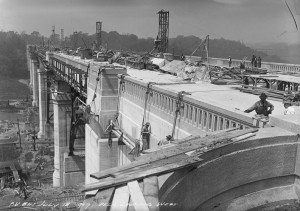Cabbagetown is a neighbourhood located on the east side of downtown Toronto, Ontario, Canada. It comprises “the largest continuous area of preserved Victorian housing in all of North America”, according to the Cabbagetown Preservation Association.
Cabbagetown’s name derives from the Irish immigrants who moved to the neighbourhood beginning in the late 1840s, said to have been so poor that they grew cabbage due to potato famine in their front yards. Canadian writer Hugh Garner’s novel, Cabbagetown, depicted life in the neighbourhood during the Great Depression.
History
The area today known as Cabbagetown was first known as the village of Don Vale, just outside of Toronto. It grew up in the 1840s around the Winchester Street Bridge, which before the construction of the Prince Edward Viaduct was the main northern bridge over the Don River. This was near the site where Castle Frank Brook flowed in the Don River. By the bridge the Don Vale Tavern and Fox’s Inn were established to cater to travellers.[2] In 1850 the Toronto Necropolis was established in the area as the city’s main cemetery.
In the late 19th century the area was absorbed into the city as it became home to the working class Irish inhabitants who were employed in the industries along the lakeshore to the south in Corktown. Brick Victorian style houses were built throughout the area. The name Cabbagetown came from stories of new Irish immigrants digging up their front lawns and planting cabbage, as had been done during the years of the Irish Potato Famine. In this era the Cabbagetown name most often applied to the area south of Gerrard Street, with the part to the north still being called Don Vale. It was a working-class neighbourhood, but reached its peak of prosperity just before the First World War, which is when many of the brick homes in the area date from.
After the war the area became increasingly impoverished. It became known as one of Toronto’s largest slums and much of the original Cabbagetown was razed in the late 1940s to make room for the Regent Park housing project. The remaining section to the north, then still known as Don Vale, was also slated for to be cleared and replaced by housing projects. In 1964 a Toronto Star writer wrote that “Cabbagetown has become a downhill ride and if you’re on way up, you don’t dare stay there for long unless you live in Regent Park.”
The construction of new housing projects was halted in the 1970s that saw the rise of the reform movement that opposed such sweeping plans. In Don Mount this effort was led by Karl Jaffary, who was elected to city council in the 1969 municipal election along with a group of like minded councillors who soon ended the urban renewal plans. John Sewell led the effort to preserve Trefann Court, that covered the southern section of the original Cabbagetown.
Cabbagetown Associations
Cabbagetown/Regent Park Community Museum
Established in 2004, the Cabbagetown/Regent Park Community Museum is a not-for-profit organization that strives to actively collect, preserve and display the history of Cabbagetown and Regent Park using oral histories, artefacts, photographs and printed material.
Aberdeen Avenue Residents’ Group
The residents of Aberdeen Avenue, named for Lord Aberdeen and his wife Lady Ishbel Aberdeen, established an active community association in 2006, the Aberdeen Avenue Residents’ Group (AARG) to address issues unique to this Cabbagetown street.
Don Vale Cabbagetown Residents Association
The Don Vale Cabbagetown Residents Association (DVCRA) was originally established in 1967, according to its website. It states its purpose to be protecting and improving the general quality of life and character of the community. The association defines its western boundary as Parliament Street.
Cabbagetown South Association
The area between Sherbourne St. and Parliament St., from Shuter St. to Carlton St. has its own residents’ association, Cabbagetown South Association. Cabbagetown South Association was formed in 2002 from the amalgamation of Central Cabbagetown Residents Association (CENTRA), which previously represented the part of Cabbagetown South that is north of Gerrard Street E., and the Seaton Ontario Berkeley Residents Association (SOBRA), which previously represented those streets south of Gerrard Street E.
 Cabbagetown Info Events, reviews and what's happening in Cabbagetown, Toronto
Cabbagetown Info Events, reviews and what's happening in Cabbagetown, Toronto

